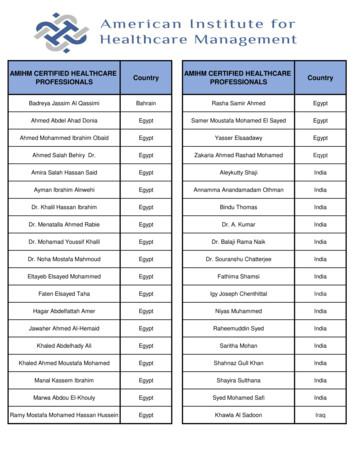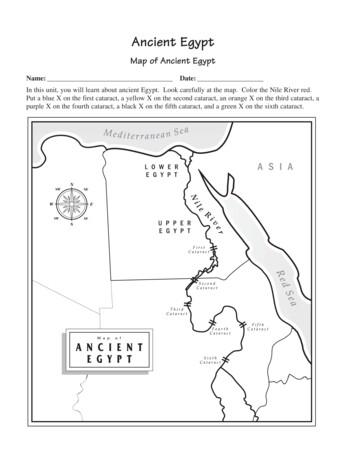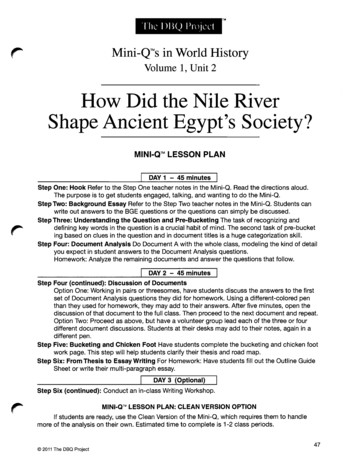Ancient Egypt Kids - World Book Online
World Book Online:The trusted, student-friendly online reference tool.Name: Date:Ancient EgyptYou are about to go back in time 5,000 years to a place called Ancient Egypt! As you move back in time,you’ll get a taste of the daily life (and after-life!) of a typical Egyptian. Stick around – you may evenget to see one of the Seven Wonders of the World!First, go to http://www.worldbookonline.comThen, click on “Kids.” If prompted, log on with your ID and Password.What’s the Word?Use the “Search” tool to find the definitions of the words below. You can also find the definition ofalmost any word on the World Book database by double-clicking on it!1. Hieroglyphics A. A dead body that has been preserved.2. PyramidsB. Creatures from ancient myths that often had lion bodies and human heads.3. PharaohC. Paper-like writing material.4. PapyrusD. A picture or written symbol used to represent a sound, a word, or an idea.5. MummyE. The title used for a king in ancient Egypt.6. SphinxF. Large, triangular structures that were used as tombs or temples.Find It!Find the answers below by using the “Search” tool to search key words. Since this activity is aboutAncient Egypt, you may start by searching the key words “Ancient Egypt.” Write the answers beloweach question.7. About how long did the great Ancient Egyptian civilization last?8. How old are the Egyptian pyramids?9. The people of Ancient Egypt depended on what major river for their water? 2015 World Book, Inc. Chicago, Illinois, U.S.A. All rights reserved. World Book and the globe device are trademarks or registered trademarks of World Book, Inc. This webquest maybe reproduced without World Book’s permission provided that it is reproduced exactly as published by World Book and is reproduced for entirely non-commercial educational purposes.Any other reproduction of this webquest, in whole or in part, in any form, requires the express written permission of World Book, Inc., and may require the payment of a fee.
10. Where did most people live in Ancient Egypt?11. Name at least two types of goods that the Egyptians got through trade.In the article “Ancient Egypt,” look at the maps of Ancient Egypt to answer the questions below.These maps are also located in the “Pictures, Videos, and More” tab at the top of the page.12. What sea is closest to Lower Egypt?13. Name two cities located on the Nile River.14. What modern city is located by the pyramids?15. What are the names of the three pyramids pictured in the map?Watch It!In the World Book article “Mummy,” find the video “WB Explains: Why didEgyptians mummify their dead?” and answer the questions below:16. What was the main point of mummification for the Egyptians?17. What did friends and family leave at the tomb for the deceased?18. Where did Egyptians bury their dead before they started to mummify them? 2015 World Book, Inc. Chicago, Illinois, U.S.A. All rights reserved. World Book and the globe device are trademarks or registered trademarksof World Book, Inc. This webquest may be reproduced without World Book's permission provided that it is reproduced exactly as published byWorld Book and is reproduced for entirely non-commercial educational purposes. Any other reproduction of this webquest, in whole or in part, inany form, requires the express written permission of World Book, Inc., and may require the payment of a fee.
Draw It!In the article “Ancient Egypt,” go to the tab called “More Information.” Click on “Activities” and“Count like an Ancient Egyptian.” Read the instructions and use the ancient Egyptian numeralsto answer the questions below.19. Using Egyptian numerals, write your age in years.20. Using Egyptian numerals, write your height in inches.21. Using Egyptian numerals, write how many people are in your family.21. Using Egyptian numerals, write how many kids are at your school.(You may need to ask your teacher.)Read more by visiting World Book’s eBook collection:Ancient Egyptians. Chicago: World Book, 2013. Early Peoples. World eBook. Web. 15 Oct. 2015. t/catalog/urn:ISBN:978-0-7166-2331-1/detail.do . 2015 World Book, Inc. Chicago, Illinois, U.S.A. All rights reserved. World Book and the globe device are trademarks or registered trademarks of World Book, Inc. This webquest maybe reproduced without World Book’s permission provided that it is reproduced exactly as published by World Book and is reproduced for entirely non-commercial educational purposes.Any other reproduction of this webquest, in whole or in part, in any form, requires the express written permission of World Book, Inc., and may require the payment of a fee.
Teacher PageUse the Ancient Egyptian on-the-go activity as an engaging way to introduce students to the lifeand terminology of Ancient Egypt.Answers:1. D2. F3. E4. C5. A6. B7. Ancient Egypt lasted more than 2,000 years.8. The Egyptian pyramids are about 4,500 years old.9. The Egyptians depended on the Nile River.10. Most Egyptians lived in villages outside of the cities.11. The Egyptians got gems, gold, and other riches through trade.12. The Mediterranean Sea is closest to Lower Egypt.13. Memphis and Thebes are located on the Nile River.14. Giza is located near the ancient pyramids.15. The Great Pyramid of Khufu, the Pyramid of Khafre, and the Pyramid of Menkaure arepictured on the map.16. To Egyptians, it was important to be able to preserve the body of the deceased, so that thespirit (the “Ka”) was able to locate its own body after death.17. Food and drink and things needed in life were left for the dead.18. Before Egyptians mummified the bodies of the dead, they buried them directly intothe sand where the dry heat naturally mummified the bodies. Once bodies were buried intombs, it was necessary to mummify bodies to preserve their appearance.19. Answers will vary20. Answers will vary21. Answers will vary22. Answers will vary 2015 World Book, Inc. Chicago, Illinois, U.S.A. All rights reserved. World Book and the globe device are trademarks or registered trademarks of World Book, Inc. This webquest maybe reproduced without World Book’s permission provided that it is reproduced exactly as published by World Book and is reproduced for entirely non-commercial educational purposes.Any other reproduction of this webquest, in whole or in part, in any form, requires the express written permission of World Book, Inc., and may require the payment of a fee.
In the article “Ancient Egypt,” go to the tab called “More Information.” Click on “Activities” and “Count like an Ancient Egyptian.” Read the instructions and use the ancient Egyptian numerals to answer the questions below. 19. Using Egyptian numerals, write your age in years. 20. Using
A Kids Book About Racism by Jelani Memory . A Kids Book About Failyure by Dr. Laymon Hicks . A Kids Book About Creativity by Sara & Stewart Scott-Curran . A Kids Book about Empathy Daron K. Roberts . A Kids Book About Bullying Elizabeth Tom. A Kids Book About Belonging Kevin Carroll. A kids
Around 3100 BC, there were two separate kingdoms in Egypt, Upper Egypt and Lower Egypt. Soon aerwards, King Narmer (from Upper Egypt) united the t wo kingdoms. When the unificaon happened, it became the world ’s first ever na†on -state. King Narmer was the first king of Egypt ’s
Ahmed Abdel Ahad Donia Egypt Samer Moustafa Mohamed El Sayed Egypt Ahmed Mohammed Ibrahim Obaid Egypt Yasser Elsaadawy Egypt Ahmed Salah Behiry Dr. Egypt Zakaria Ahmed Rashad Mohamed Eqypt Amira Salah Hassan Said Egypt Aleykutty Shaji India Ayman Ibrahim Alnwehi Egypt Annamma Anandamadam Othman India
This is the third paper in a series of research papers exploring the history of mechanical engineering during the Ancient Egypt era. The industry of necklaces in Ancient Egypt is investigated over seven periods of Ancient Egypt History from Predynastic to Late Period. The paper presents samples of necklaces from the seven periods and tries to .
Egypt was a grassland. Nomads traveled in search of food King Menes united Upper & Lower Egypt. Established capital at Memphis. Age of Pyramids. First man made mummies Romans take control of Egypt. Egypt never rises to greatness again. Alexander the Great conquers Egypt. Cleopatra is the last Phar
The first pharaoh of Egypt was Narmer, who united Lower Egypt and Upper Egypt. Egypt was once divided into two kingdoms. The kingdom in Lower Egypt was called the red crown and the one in Upper Egypt was known as the white crown. Around 3100 B.C. Narmer, the pharaoh of the north, conquered the south a
Ancient Egypt Vocabulary (cont.) 13. Nubia—ancient civilization located to the south of Egypt 14. Old Kingdom—period in ancient Egyptian history from 2686 B.C. to 2181 B.C. 15. papyrus—a plant that was used to make paper 16. pharaoh—ancient Egyptian ruler who was believed to be part god and part human 17. phonogram—a picture that stands for the sound of a letter
more true than in the ancient kingdom of Egypt. Ancient Egypt was a world of contrasts and op- posites, a place of hot, sunny days and cold nights, of crop- laden fields and empty desert. In its early time, the kingdom was actually two distinct lands called Upper Egypt (the higher the delta. Irrigation channels from the Nile flowed to smaller























